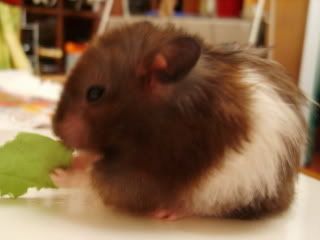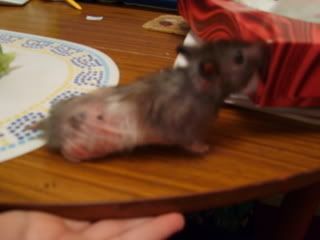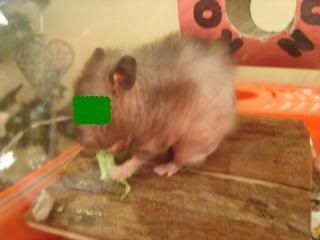 Cushing's Syndrome in Syrian Hamsters
Cushing's Syndrome in Syrian Hamsters

What is Cushing's Syndrome?
Cushing's Syndrome is caused by a tumour in the Pituitary gland in the brain. This causes irregular hormone production, which leads to some, or
all, of the following symptoms appearing in the hamster:
- Hair loss
- Weight loss
- Loose skin and dry, flaky skin
- Wasting of the skeletal muscles, resulting in impaired movement
- Increased thirst and production of urine
- Dark pigment patches on the skin (not to be confused with the normal scent patches found on the hips)
- Cuts, scabs or wounds on the skin, which may become infected
Which Hamsters are Vulnerable to Cushing's Syndrome?
There are no preventative measures to ensure that your hamster does not develop Cushing's. There are no environmental factors that can increase
or decrease your hamster’s chances of getting Cushing's Syndrome. It cannot be caught or passed on from one hamster to another.
There is no scientific evidence to suggest that certain colours of hamster are more likely to develop Cushing's Syndrome, but in my experience,
the majority of hamsters diagnosed with Cushing's have been black or sable (either banded or not). I have also known of the occasional Golden with
Cushing's Syndrome. I have never heard of Cushing's appearing in cream lines, for example. As I stated, this is only from my own limited
observations and is in no way scientific proof or empirically tested evidence.
The best way to decrease your chance of purchasing a hamster that will later develop Cushing's Syndrome is to purchase from a well-known,
reputable breeder, such as those who regularly display at National Hamster Council shows (UK only). Such breeders keep genetic records of all
their hamsters and can tell you if they’ve ever had a hamster that’s developed Cushing's Syndrome (the likely response will be never).
Responsible breeders would discontinue a genetic line where illnesses, such as Cushing's, appear. You cannot rely on pet shops to practice such
behaviour, as they keep no genetic records and do not stay in contact with buyers to find out if any problems develop with their hamsters. The
hamster that will feature as a model in this article is from a well-known pet shop chain.
 Picture taken about 1 month after start of Cushing's Syndrome
Picture taken about 1 month after start of Cushing's Syndrome
Cushing's Syndrome Timeline
What course does Cushing's usually take?
This timeline explains how the symptoms first appear and how they develop over time. You can use this guide to spot Cushing's Syndrome
developing in your hamsters and as a guide for what to expect.
It is unusual for these symptoms to develop in a hamster under one year old. The average age for a hamster to develop Cushing's Syndrome
appears to be between 14 and 18 months.
Cushing's Syndrome always presents initially with hair loss. This is the first sign that your hamster may have Cushing's. However, it is also
very common for hamsters of this age to have hair loss that is unrelated to illness. It is also possible for hamsters to loose hair due to an
infestation of mites, for which veterinary treatment must be sought. Therefore, it is difficult to diagnose early-stage Cushing's Syndrome in
hamsters. A diagnosis of Cushing's Syndrome is usually given if the hair loss worsens in spite of treatment for mites and results of skin-scrape
tests being negative for mites.
There is currently no veterinary treatment for Cushing's Syndrome in hamsters, unlike in cats and dogs, for whom medication can manage the
illness. This treatment cannot be given to hamsters, as it is far too strong for them. It could be possible to prescribe a much lower dosage of
these drugs for hamsters, but most vets will not offer this treatment, as it is not licensed.
The hair loss in Cushing's Syndrome usually begins in one or more of the following places:
- The underside of the hamster, near the genitals.
- Around the scent glands on the hips
- Just above the tail
In a couple of months the hair loss progresses quite rapidly, so that almost all hair on the rear end and belly is lost, leaving a few tufts
here and there.
 Picture taken about 3.5 months after start of Cushing's Syndrome
Picture taken about 3.5 months after start of Cushing's Syndrome
You may now notice dark pigment spots appearing on the skin and some new hair may even start to grow. This often provides false hope that the
hamster is recovering. As the next couple of months pass, much more hair will be lost. The hair loss will progress further towards the head on
both the back and the belly. Luckily, the head tends to be the last place that hair loss begins.
At this stage, you will likely notice your hamster drinking more and the cage beginning to smell before it is due to be cleaned. This is due to
extra urine production. The cage will now need to be cleaned about every 5 days.
By this point, you’ll also notice your hamster loosing weight and looking smaller and thinner. Provide extra nesting material for warmth. You
may also notice cuts appearing on the skin. Remove sharp toys, such as wooden objects, as the exposed skin is delicate and vulnerable. The hamster
will develop wounds and scabs caused by the disease, so as long as the toys aren’t sharp or rough, do not feel guilty about wounds and scabs
developing. You will also notice that the skin is becoming wrinkled and also dry.
 Picture taken 4.5 months after start of Cushing's Syndrome
Picture taken 4.5 months after start of Cushing's Syndrome
It will be helpful to your hamster if you purchase some special cream, marketed for dry skin in animals. In the UK, this can be purchased from
Pets at Home. You may also be able to buy a similar product from your vet. This cream, applied once or twice a day, will really comfort the
itching that your hamster will experience. Apply the cream liberally to the skin. You will most likely need the help of another person to hold the
hamster whilst you apply the cream.
At this time, you will also start to notice the hamster sleeping much more and wanting fewer playtimes. However, when the hamster is awake,
they will be as enthusiastic as ever to come out and play. At this point, the hamster does not seem to be in any particular discomfort or pain,
aside from itching, which is helped by the cream.
It is very important to the emotional well being of your hamster that you hold them and play with them as normal, or someone else does so, even
if the hair loss and changed appearance of your hamster puts you off. The hamster will not understand if you don’t hold them as much as usual
and will get depressed at lack of human contact. Your hamster needs to feel that you still love them just as much as before the illness. Stroke
the tufts of hair that still remain on you hamster. They will not usually become 100% bald.
How will it end? - How will the hamster die?
The majority of hamsters with Cushing's Syndrome have to be taken to the vet to be put to sleep to end their suffering. Not many pass away
naturally before suffering begins. I hope the information in this section will help you to decide on the right time to euthanise your special
little friend. In my opinion, there are two main symptoms to look out for that tell you the time has come:
1) Infected wounds - The model hamster used here developed two large wounds on the belly that became infected. They were
yellow-grey in colour and smelled strongly.
2) Impaired movement- As the disease progresses, you will notice your hamster’s movements becoming increasingly impaired. At
fist, this will simply be slowness in movement and will not be troubling the hamster too much; they may just appear a little stiff. At this point,
the hamster may need to be transferred to a large one-level cage or tub, if they are not in such a cage already, as they will not be able to climb
up to different levels or climb tubes. It is very important to keep an eye on your hamster’s movement. If the hamster becomes too impaired, for
example having difficulty in walking or straightening their back, then it is kinder to euthanise immediately. Ensure that your hamster can reach
the water bottle right up until their final day.
Only you can make the final decision about when to euthanise, as you know your hamster the best. It is important not to go on holiday during
your hamster’s final weeks, in case they suddenly worsen and need euthanasia. The model hamster worsened in one day and was euthanised
immediately.
When you make the appointment, inform the vet that it is for euthanasia. They will prepare a form for you to sign, giving your permission. You
can either have your hamster cremated at the vets or take the body home to bury in the garden. These options will be on the form.
The vet will be very gentle and sympathetic. They will not mind if you cry and will often give you a few minutes alone with your hamster, to
say goodbye. Most people wish to stay with their hamster as the lethal injection is administered. However, it is difficult to find veins in
hamsters and the vet may suggest that your hamster is gently put unconscious with gas, before the injection is administered. This means that the
hamster does not feel the needle or suffer any pain from a vein not being able to be located. Your hamster will be taken to a glass chamber where
they will feel no pain and gently fall to sleep. Then the lethal injection will be administered to stop your hamster’s heart, while they are
sleeping.
The whole process takes about five minutes and your hamster feels no pain. Your hamster will then be returned to you, in a peaceful, sleeping
position, wrapped in a tissue or blanket.
Article written by Bunsey who can be contacted via:


This page was last edited on
October 14, 2011